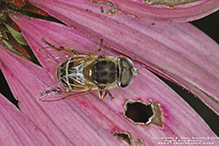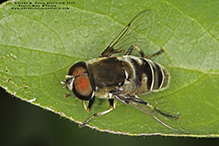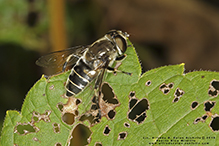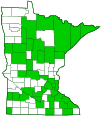black-shouldered drone fly
(Eristalis dimidiata)
Conservation • Description • Habitat • Ecology • Distribution • Taxonomy
|
|
||||||||||||||
Description |
Black-shouldered drone fly is an early, common, hairy, medium-sized hoverfly. It occurs in the United States east of the Great Plains, and in southern Canada. It is common in Minnesota. It is one of the earliest hoverflies to emerge in the spring. Adults are found from April to late September mostly in forests. They feed on flower nectar. The larvae, known as rat-tailed maggots, are aquatic. They live in polluted water or in wet carcasses. They feed on small organisms. Adults are robust, slightly bee-like in appearance, and ⅜″ to 9⁄16″ (10.1 to 14.0 mm) in length. The head is hemispherical and slightly broader than the thorax. There are two large compound eyes on the sides of the head and three small simple eyes (ocelli) in a triangle on top of the head. The compound eyes are densely covered with short erect hairs, at least on the upper half. On the male they meet at the top of the head. On the female they do not. They are not spotted or banded. The face is densely hairy and is not projected forward. The antennae are short and are inserted near the middle of the head. They are dark brown and have just three segments. The first and second segments are short. The third segment is flat and longest on the bottom, shorter and rounded on top. At the base of the third segment there is a long, forward-pointing bristle (arista) on the upper side. The arista has a tight group of one to six short bristles on the upper side near the base. It is otherwise bare, not feather-like (plumose). The protruding mouthpart (proboscis) is short and fleshy. The thorax is dark blackish-brown, shiny, unmarked, and densely covered with short, erect, whitish hairs. It has three segments. Each segment has four principal exoskeletal plates, one above, one below, and one on each side. The upper (dorsal) plates, from front to rear, are the prescutum, scutum, and scutellum. There is a convex swelling, called the posterior callus or postalar callus, on the upper rear corners of the scutum. At least some of the hair on the posterior callus and most of the hair on the base of the scutellum is black. This is the feature that gives the insect its common name, but it is difficult to see without a very clear photograph. The scutellum is not fringed. The abdomen is black and is densely covered with short erect hairs. It has five segments. The first segment is narrow and entirely black. The second segment has a broad yellowish band that is broken in the middle. The third segment often has a similar but narrower orangish band. The second, third, and fourth segments each have a narrow white band on the rear margin. The fifth segment is small and entirely black. Some females show no yellow or orange spots on the abdomen. The wings are mostly clear. Near the wing base there is a short cross-vein, the humeral vein (h), between the costa (C) and subcosta (Sc) veins. From the h to the base the wing is dark brown. Toward the wingtip, the second cell (pterostigma) on the leading edge (costal margin) is dark brown and distinct. There is a spurious vein between the radius (R) and media (M) veins. The R4+5 vein is deeply bent (sinuous), appearing “bumped” downward in the middle. The anal cell is long and is closed near the wing margin. The marginal, R1, R5, and M2 cells are also closed. The legs are mostly black. The basal half of the fourth segment (tibia) of each leg is white and sharply demarcated. |
Size |
Total length: ⅜″ to 9⁄16″ (10.1 to 14.0 mm) |
Similar Species |
Habitat |
Forests |
Ecology |
Season |
April to late September (CCESR) April 27 to late September 11 (Telford) |
Behavior |
|
Life Cycle |
Adults overwinter. |
Larva Food |
Small organisms |
Adult Food |
Flower nectar |
Distribution |
||
|
Sources Telford, Horace S.. (1939). The Syrphidae of Minnesota. University of Minnesota. Minnesota Agricultural Experiment Station. |
|
| 10/1/2024 | ||
Occurrence |
||
Common |
||
Taxonomy |
|
Order |
|
Suborder |
Brachycera |
Infraorder |
Cyclorrhapha |
Zoosection |
Aschiza |
Family |
Syrphidae (Hover Flies) |
Subfamily |
Eristalinae (Drone Flies and Allies) |
Tribe |
Eristalini (Rat-tail Maggot Flies) |
Subtribe |
Eristalina |
Genus |
|
Subgenus |
Eoseristalis |
Subordinate Taxa |
|
|
|
Synonyms |
|
Eristalis chalybaeus Eristalis chalybeus Eristalis dimidiatus Eristalis haesitans Eristalis incisuralis Eristalis inflexus Eristalis l'herminierii Eristalis niger Eristalis pervagus |
|
Common Names |
|
black-shouldered drone fly |
|
Glossary
Arista
A large bristle on the upper side of the third segment of the antenna of a fly. Plural: aristae.
Costal margin
The leading edge of the forewing of insects
Ocellus
Simple eye; an eye with a single lens. Plural: ocelli.
Proboscis
The tube-like protruding mouthpart(s) of a sucking insect.
Pterostigma
The dark, blood-filled second cell at the leading edge of each wing toward the tip on many insects. It is heaver than adjacent, similar sized areas and is thought to dampen wing vibrations and signal mates. (= stigma. More precise than stigma but less often used, even by entomologists.)
Scutellum
The exoskeletal plate covering the rearward (posterior) part of the middle segment of the thorax in some insects. In Coleoptera, Hemiptera, and Homoptera, the dorsal, often triangular plate behind the pronotum and between the bases of the front wings. In Diptera, the exoskeletal plate between the abdomen and the thorax.
Scutum
The forward (anterior) portion of the middle segment of the thorax (mesonotum) in insects and some arachnids.
Tibia
The fourth segment of an insect leg, after the femur and before the tarsus (foot). The fifth segment of a spider leg or palp. Plural: tibiae.
Visitor Photos |
||
Share your photo of this insect. |
||
This button not working for you? |
||
Alfredo Colon |
||
 |
 |
|
 |
 |
|
MinnesotaSeasons.com Photos |
||
|
||
|
||

Slideshows |
|

Visitor Videos |
||
Share your video of this insect. |
||
This button not working for you? |
||
|
Other Videos |
||
Flower Fly (Syrphidae: Eristalis dimidiata) Bee Mimic |
About
May 16, 2011 Photographed at Grand Forks, North Dakota (16 May 2011). Thank you to Martin Hauser (@Bugguide.net) for identifying this specimen! |
Bee Mimic Flower Fly (Syrphidae: Eristalis dimidiatus?) Close-up |
About
Apr 24, 2012 Photographed at Grand Forks, North Dakota (24 April 2012). |

Visitor Sightings |
||
Report a sighting of this insect. |
||
This button not working for you? |
||
Alfredo Colon |
Location: Albany, NY |
 |
| Alfredo Colon 8/23/2019 |
Location: Woodbury, MN |
 |
| Alfredo Colon 8/22/2019 |
Location: Woodbury, MN |
 |
| Alfredo Colon Summer 2019 |
Location: Woodbury, MN |
 |
MinnesotaSeasons.com Sightings |
||
|

Created: 1/6/2021 Last Updated: © MinnesotaSeasons.com. All rights reserved. |
